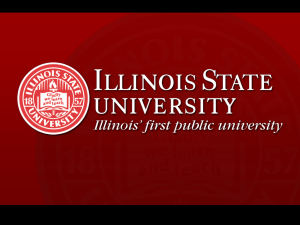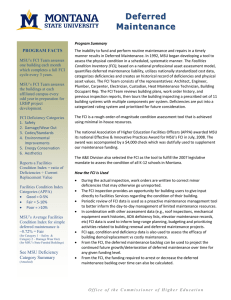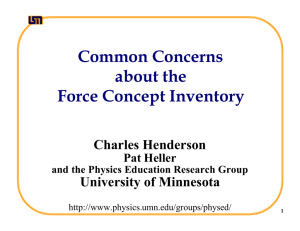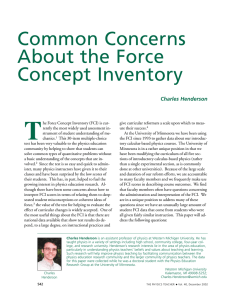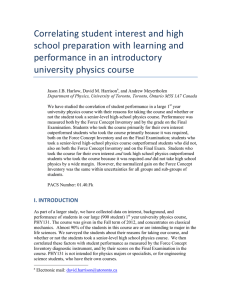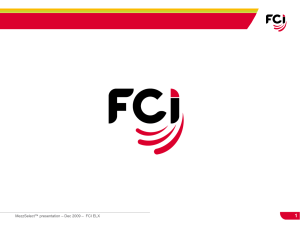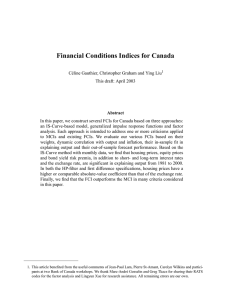Identifying students' conceptual difficulties with projectile motion in
advertisement
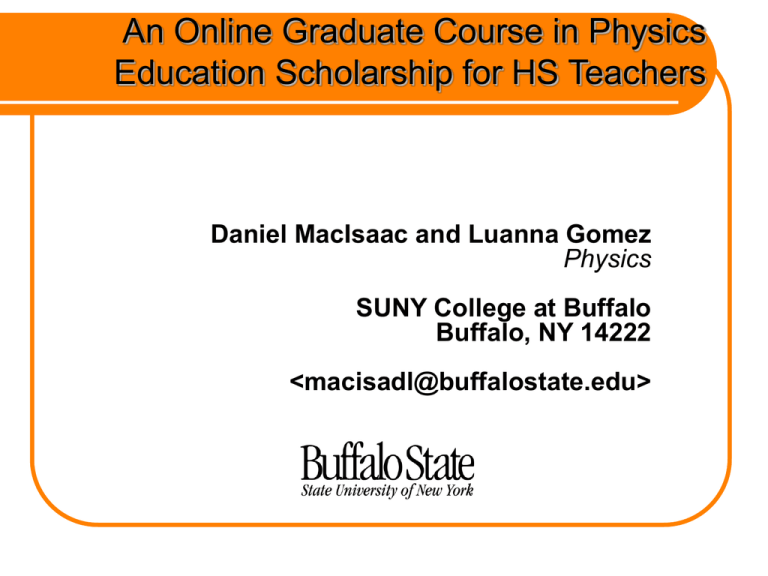
An Online Graduate Course in Physics Education Scholarship for HS Teachers Daniel MacIsaac and Luanna Gomez Physics SUNY College at Buffalo Buffalo, NY 14222 <macisadl@buffalostate.edu> Abstract PHY500: Physics Education Seminar (online) is designed to lay a foundation of Pedagogical Content Knowledge (PCK) in high school Physics Teaching scholarship, to engage high school Physics Teachers as practical consumers of physics and science education scholarship, and to foster critical reflection on their own teaching practices. We describe content, activity, and lessons learned from offering PHY500 to more than 75 high school physics teachers since 2002. Program and PHY500 Course Goals PHY500: Seminar in Physics Education is a required intro course for two terminal masters' programs: • • M.S.Ed. (Physics) mainly taken by BIO, CHM, GLG, some MAT, some PHY teachers M.S.Ed. (Physics with NYSED Transitional B Certification) for STEM professional becoming teachers Note that most NY teachers certify twice – to earn full (NYSED Professional) certification teachers must obtain a suitable masters degree. These programs enroll about fifty graduate students at present, with almost another fifty alumni. Seventy-eight students have completed PHY500 since it was first offered in 2002. PHY500 has always been an online offering, taught by the authors only to date. Program and PHY500 Course Goals Considerations underlying PHY500 included: Develop physics teacher Pedagogical Content Knowledge by fostering critical reflective thinking about • • • • the state of teachers' own physics subject knowledge and pedagogical knowledge (Arons; Beichner; Hestenes, Wells & Swackhamer; McDermott & Redish; McDermott & Shaffer, -standard instruments like FCI, TUG-K etc; PER and SER touchstone activities) teachers' and students' own physics learning (Beichner; Hake; Hestenes, Wells & Swackhamer, teachers' own physics teaching (Arons; Hake, MacIsaac & Falconer; Sawada, Baker, Bauer, Benford, Birk, Bloom and Falconer) expose students through readings to a wide variety of researchinformed physics learning experiences and practices (Finklestein, Adams, Keller, Perkins & Podolefsky; Sokoloff & Thornton; Thornton)) Program and PHY500 Course Goals Considerations underlying PHY500 included: (more mundanely): develop teacher familiarity with appropriate literature for an eventual PHY690: Masters' Project must be offered online to enroll downstate (NYC, Long Island) and out of state students must expose students to M.S.Ed. (Physics) programs philosophy and shared definitions of what good physics learning environment can look like (Reformed Teaching Observation Protocol) must assess candidate dispositions for physics teaching (particularly alternate certification candidates) for M.S.Ed. (Physics) Programs at beginning and end of program (NCATE; candidate advising and counseling) develop graduate student scholarly reading and writing skills (APA format, scholarly discourse) Program and PHY500 Course Goals What PHY500 is NOT: A literature course for PER researchers or Doctoral Candidates. This is a course for teachers – professional educational practitioners. In general these folk are consumers of PER and SER literature. We'd like these teachers to become future master physics teachers and future teacher leaders able to make critical, informed decisions about their own physics classroom learning and teaching practices, physics curricula, professional development and their own profession. PHY500 Weekly Course Activity: All weekly reading assignments given at the start of the course participants write 3-5 page reflective reaction papers • • • • • readings are not summarized the goal is instead to first identify ONLY one or two ideas within the readings that resonate with the lived experience (either teaching or learning physics) of the participant lived experiences are then analyzed through the reading, and described by the participant submit these reflective reaction papers on a Monday expected to comment on a colleagues’ paper by Thursday in a roundrobin format • • comments on both writing mechanics (spelling grammar, format, readability) intellectual content PHY500 Weekly Course Activity: • • • original essays and marked up annotated essays (all done in MS Word) are shared with all class students on a password protected Angel (originally BlackBoard) class website week one: instructor annotates every essay during (Arons Ch1) rest of the course: instructor reads and briefly comments on essays a rubric and exemplars are available to participants to guide their weekly annotations of one another lengthier final paper on a negotiated individual topic tried and abandoned chat sessions Participant Quotes For example a Chemistry teacher becoming a physics teacher reflects on their own mechanics knowledge and the FCI: This past summer was the first time I took the FCI or knew what it was, and it was an eyeopening experience for me. I realized that despite all of the formulas I had learned and the problem solving skills that I had, I was very unsure of some basic concepts about forces in physics, and now, after taking it a few times, I’m quite sure that I failed it horribly the first time. However, I’ve learned a lot over the last 9 months and this time I did extremely well. … One of the most important things about the FCI is knowing how this test can be used and what its purpose is. Without knowing these things the test is worthless. First, the FCI is “not a test of intelligence; but is a probe of a belief system.” Its purpose is to determine whether a student has excepted (or adopted) a Newtonian view of forces or whether they believe in commonsense alternatives based of life experiences. So really its purpose is to address common misconceptions (or preconceptions, as Arons would call them). This test will not tell you which students are going to do well on a conventional physics test or regents exam because it is purely conceptual and does not assess mathematical skills, memorized formulas, or problem solving skills. Participant Quotes Interpreting her own lived experiences in college via Sokoloff and Thornton’s ILDs: Sokoloff and Thornton’s ILD (Interactive Laboratory Demonstrations) force students to do something they usually don’t. It forces them to think about and process the information. Better yet, for those students who already knew they needed to process the information, it give them time to process, and also to discuss the information with their peers. My lectures in college made no sense to me. The way I would figure information out was to form a study group, take my copiously copied lecture notes with me and all of us would have a powwow trying to decipher what it all meant. Usually we would only be able to get so far and then all of us would draw straws to pick who got to go ask the professor the questions we needed answered to further our understanding. I usually got the short straw. Having the chance to discuss physics concepts in class, with the professor right at our finger tips if we got stuck would have been a great learning environment in college. Participant Quotes A teacher partially analyzes her own Classroom practice through Beichner’s TUG-K article: The last thing I’ve tried with my students is to have my students write a story or pick a pre-existing nursery rhyme and graph a distance verses time, velocity verses time and acceleration verses time graph for the motion of the character in the story. Students had some difficulty with this as well. I modeled the IstyBitsy Spider for them (I got this out of the STAR review book if anyone is interested) and then had them come up with their own. Many of my students chose Jack and Jill. They were able to draw the displacement verses time graph but the other graphs were mostly unsuccessful attempts. I would say about a third of my students drew all three graphs for Jack and Jill to look like a hill, which does make reasonable sense, but everything was down hill from there. The velocity vs. time graphs looked similar and so did the acceleration verses time graphs. Beichner’s research showed very similar results. In fact he said that thinking about a graph as an actual picture of motion was the most common mistake a student makes. I could definitely see that most of my students needed more work on graphing, but after spending two weeks on it, I had to move on. I was a little discouraged because after spending so much time the progress was very small. PHY500 Lessons Learned: Online teaching is a LOT of work, and it is difficult to get high quality discourse online Enrollment is pretty high (about 12 / year) and a large fraction enroll in PHY500 as non-degree or visiting students, then apply to one of the M.S.Ed. programs and change degree status Some activities are less suitable for teachers – the “Purer PER and SER” seems to become less compelling as classroom immediacy is lost -- E.g. in order of less to more immediate readings: Less Accessible More Accessible Piaget (no more); Hake; FCI, Batteries and Bulbs, ILDs Arons is highly accessible; seen as a reference work (used also in PHY518, 520, 525, 620, & 622) PHY500 Lessons Learned: Teachers often are initially taken aback by their self-scored standardized conceptual physics instrument results – they don’t know what they don’t know initially. Teachers love the standardized conceptual physics instruments like FCI, TUG-K; we literally restrain teachers from starting their own research as these M..S.Ed. programs do not teach research methods. Many teachers do informally explore use of these instruments in their classes (esp. FCI). Some PHY500 students who are working physics teachers can test ideas from PER readings in their classes and report back that very week to the class (extraordinarily powerful).



